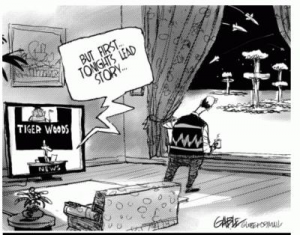Posts Tagged "society"
Celebrity Obsession
Mrs Alex just forwarded me this great cartoon illustrating how off-kilter our media’s focus is. Why do they think we care so much about celebrities’ private lives? Why can’t the media focus more on the important things in the world like international affairs, social change and the like. Tiger Woods’ private life should be his own.
His statement had an interesting quote on this:
“Personal sins should not require press releases and problems within a family shouldn’t have to mean public confessions.”
I wholeheartedly agree.
I remember once watching an episode of Sliders (a sci-fi show which explores “what-if” situations by having the protagonists visit parallel universes). In the episode Eggheads they visit a parallel Earth where scientists, classical pianists and philosophers are the celebrities of the day. Where intelligence is cool and wisdom is revered.
(Update: Check out this video clip in my follow on post)
Sometimes I wish our world could be more like that. Is it really so crazy that medical breakthroughs should be more important than last-minute penalty shootouts or that technological innovations should be more interesting than celebrities’ personal lives?
</wild-speculation>
Technology isn’t the answer to every problem
I think the strongest message of last night’s Challenge Your World event was this excellent short video by Sebastian Baptista from Uruguay. A simple idea, powerfully conveyed. Technology is not the answer to every problem.
Fascinating vision of the Internet age from 1990
This is Hyperland, a BBC2 documentary with Douglas Adams, Tom Baker, Ted Nelson and others, broadcast in 1990 – that’s before the World Wide Web, before DVDs, before digital TV, before the Internet as we know it.
What’s quite remarkable is the amount that it gets right:
- When we browse the Internet, we don’t follow a prescribed narrative path, instead we jump around and switch focus regularly to find out a random fact or branch off into a different topic.
- When watching video footage or listening to an MP3, we can skip to different sections (think DVD chapter menus or podcast position markers). We can click out to related content (think YouTube timelined clickable comments or BBC’s interactive TV “red button”)
- We can create representations of ourselves in the virtual world as we explore and communicate with others, from social website profiles through to Second Life avatars
- We are just beginning to be able to use technology such as Layar or Pocket Universe to augment reality with additional useful information
- The nature of the documentary itself, skipping as it does between items of interest, is an interesting portent of today’s short-attention-span, focus-shifting approach to consuming information.
- It correctly predicts that one of the biggest challenges is the need for a language for “hypertext” (remember this is before HTML was invented).
It even predicts some things we are only just beginning to see, such as interactive storytelling and intelligent software agents.
All in all, well worth 50 minutes of your time if you are interested in changes in technology and media and their effect on society.
I found this today on Russell Davies‘ blog.
What if we didn’t need factories any more?
That is the thought-provoking possibility suggested by the RepRap project. RepRap is a simple 3D printer that can make plastic objects to any design, on your desk, using an ordinary PC. It can even make a copy of itself. It’s entirely open source and freely distributable.
Ryerson University, the University of Western Ontario, Rabble and The Tyee have also started a very interesting multimedia project to explore this technology and the effects it will have on society further, called Maker Culture. You can read a good introduction by Wayne MacPhail here.
I am intrigued to see where this might lead. Developments in computing capability and internet technology have given us recording studios, photo labs, broadcasting studios, video editing suites and printing presses from our desktop – and have completely changed those industries as a result.
What changes can we expect in the world’s manufacturing industries if goods no longer needed to be manufactured and distributed, but instead you downloaded a design and printed it yourself at home (much like you download an MP3 or movie and burn a CD or DVD now)?
Certainly this is a technology in its infancy, but full of promise. I can’t wait to see how this develops.
Posted via web from Bowyer’s Bite-size Blogettes
Read MoreHow the Internet can get the benefits of scientific research out to the public faster
Here is a video of how technology that many people have in their home can be used in ways not intended by the manufacturer. This is interesting, but even more interesting is the wider trend this represents, as Johnny Lee describes – how the Internet and new media formats such as YouTube for video distribution can quickly spread ideas to thousands of people. Not just for persuasive purposes, but to do real good, allowing any teacher or parent to create their own interactive whiteboard using a Wii remote and some cheap hardware. Scientists are already starting to talk about how they can rethink the way research is done for this information-rich, hyper-connected age we live in. It’s really exciting that scientists might finally have a way to directly explain their work to the public without having to go through journalists who don’t always understand the science, or who are encouraged to take the most sensational angle.
Exciting times are ahead, I’m sure …




